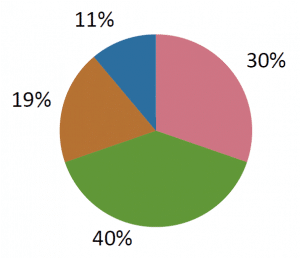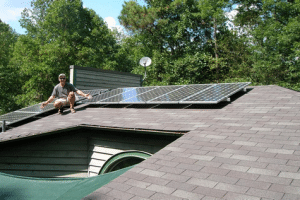Your home’s overall energy efficiency is not as exciting to think about as a solar PV system, but it is much more important in most cases. Solar PV systems are getting more affordable, but that doesn’t help much if the overall energy consumption is higher than it needs to be. An energy efficient home will require about half the PV system size as a home that is not energy efficient. There are several low cost improvements that can improve energy efficiency; there are also many improvements that require an investment but provide good return on the investment.
The division of energy consumption in a home looks similar to the following pie chart taken from the Energy Industry Administration report.


Appliances, electronics and lighting make up 40% of the home’s energy consumption. The lowest cost improvement is changing the energy user’s behavior, e.g., turn off lights and appliances when not in use. Replacing old appliances with higher efficiency ones as they require replacement, such as LED bulbs in long-hour-use fixtures.
Water heating costs can be reduced by several methods; the lowest cost methods are listed first. Insulate the hot water pipes from the water heater to the point of reduced access to the pipe. Buy and install an insulated jacket for the water heater. If your water heater fails and needs replacing, replace it with a high efficiency one. There are models that use a heat pump as the primary source of heat generation with heat coils as backup. Another, but more expensive option is to install a gas tankless water heater.
Heating and cooling together account for about 40% of the home’s annual energy usage. The best savings for the investment is to simply seal all cracks from the exterior to the interior of the home. This would be at the foundation, around doors and windows, and fixtures and access-ways to the attic. The next best investment is to improve the quality of insulation in the attic. The best insulation improvement is to have spray-foam insulation installed in the rafters and vertical walls of the attic. If there is a basement, the walls should be spray-foam insulated as well. Replacing blown-in insulation with spray-foam insulation can reduce heating and cooling costs by up to 50%. That would reduce the home’s total energy consumption by 20%.
It takes some effort and some investment to make the home energy efficient but it will not be nearly as expensive as trying to offset that portion of inefficient energy usage with a solar PV system. A 2000ft² consumes about 1800kWh/month. With an investment in spray-foam insulation, water heating insulation and replacing old appliances with high efficiency ones, it is easy to reduce the home’s energy consumption by 30% to 40% and spend less than $6000. That is about ½ the cost of a PV system to offset the same amount of energy.
Reduce energy consumption first through energy efficiency and then look at offsetting the remainder with a PV system. You may even have some money leftover to include energy storage with the PV system.
Kelly Provence
Solairgen
www.solairgen.com

